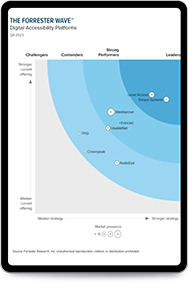The Difference Between WCAG A and WCAG AA Conformance
Dec 20, 2019
This blog was created before the release of WCAG 2.2. For information on the most up-to-date WCAG standards, visit our WCAG Compliance page.
The WCAG criteria aim to make web content more accessible to a wider audience of people with disabilities. All success criteria are important access issues for people with disabilities. They address things beyond the usability problems that might be faced by all users. There are three levels of WCAG compliance:
- WCAG A- Minimum level — without addressing these items, barriers exist that cannot be overcome by assistive technology. This level affects the broadest group with the most benefits and is essential.
- WCAG AA -More accessible — With the minimum level of support, some barriers will still exist which impact certain groups of users. The criteria at this level establish a level of accessibility which should work with most assistive technology on desktop and mobile devices. Addressing Level AA criteria may impact the look of a page or affect site logic to a greater extent.
- WCAG AAA – Even more accessible— Some AAA accessibility criteria cannot be applied everywhere, so level AAA is generally not required. That being said, even meeting level AAA does not make web pages accessible to everyone.
The WCAG criteria are cumulative—to conform to WCAG Level AA, you must first conform to A. To conform to WCAG Level AAA accessibility criteria, you just first conform to A and AA.
Understanding the success criteria
The following description of factors comes from the Understanding Conformance document created by the Accessibility Guidelines working group at the W3C.
The success criteria were assigned to one of the three levels of conformance by the working group after taking into consideration a wide range of interacting issues. Some of the common factors evaluated when setting the level included:
- Whether the success criterion is essential (in other words, if it isn’t met, then even assistive technology can’t make content accessible)
- Whether it is possible to satisfy the success criterion for all websites and types of content that the success criteria would apply to (e.g., different topics, types of content, types of web technology)
- Whether the success criterion requires skills that could reasonably be achieved by the content creators (that is, the knowledge and skill to meet the success criteria could be acquired in a week’s training or less)
- Whether the success criterion would impose limits on the “look & feel” and/or function of the web page. (limits on function, presentation, freedom of expression, design or aesthetic that the success criteria might place on authors)
- Whether there are no workarounds if the success criterion is not met
Examples of WCAG Level A vs. WCAG AA criteria
Let’s look at two familiar accessibility best practices, providing keyboard access and appropriate color contrast.
SC 2.1.1. Keyboard Access states:
2.1.1 Keyboard:All functionality of the content is operable through a keyboard interface without requiring specific timings for individual keystrokes, except where the underlying function requires input that depends on the path of the user’s movement and not just the endpoints. (Level A)
It is a Level A criterion because it’s something that can’t be worked around by assistive technology or user stylesheets. Without keyboard access, an insurmountable barrier will exist for those who require a keyboard to navigate.Adding keyboard access generally would not impact the appearance of the page.
On the other hand,SC 1.4.3 Contrast of Text and Images of Textstates:
1.4.3Contrast (Minimum):The visual presentation oftextandimages of texthas acontrast ratioof at least 4.5:1, except for the following: (Level AA)
- Large Text:Large-scaletext and images of large-scale text have a contrast ratio of at least 3:1;
- Incidental:Text or images of text that are part of an inactiveuser interface component, that arepure decoration, that are not visible to anyone, or that are part of a picture that contains significant other visual content, have no contrast requirement.
- Logotypes:Text that is part of a logo or brand name has no minimum contrast requirement.
This success criterion was placed at the Level AA level likely because it impacts the visual appearance of the page and because it can be overwritten by stylesheets.
Even though contrast is an issue for some users, the ability to work around the issue with stylesheets likely made this a Level AA criterion rather than level A.
A or AA? Which do you choose?
Most organizations and governments have decided on Level A and AA as the minimum level of conformance. Since AAA accessibility is not required and does not make web pages accessible to everyone most organizations focus on Level A and AA. Some governments and organizations have chosen to exclude a handful of criteria from a regulatory standpoint although this is not acceptable from a strict WCAG conformance level standpoint.
If you’d like to learn more about WCAG, visit our Resources Center.
Subscribe for updates

